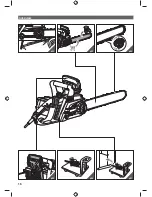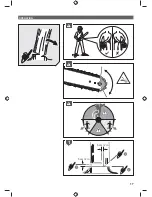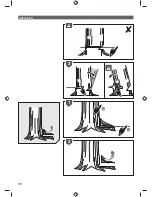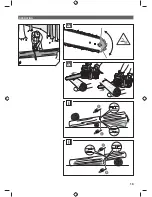
5
Ŷ
Felling back cut
See page 17 - 18.
Make the felling back cut at least 50 mm/2 in higher
than the horizontal notching cut. Keep the felling back
cut parallel to the horizontal notching cut. Make the
felling back cut so enough wood is left to act as a hinge.
The hinge wood keeps the tree from twisting and falling
in the wrong direction. Do not cut through the hinge.
As the felling gets close to the hinge, the tree should
begin to fall. If there is any chance that the tree may
not fall in desired direction or it may rock back and
bind the saw chain, stop cutting before the felling back
cut is complete and use wedges of wood, plastic or
aluminium to open the cut and drop the tree along the
desired line of fall.
When the tree begins to fall remove the chainsaw from
the cut, stop the motor, put the chainsaw down, then
use the retreat path planned. Be alert for overhead
limbs falling and watch your footing.
Removing buttress roots
See page 18.
A buttress root is a large root extending from the trunk of
the tree above the ground. Remove large buttress roots
SULRUWRIHOOLQJ0DNHWKHKRUL]RQWDOFXWLQWRWKHEXWWUHVV¿UVW
followed by the vertical cut. Remove the resulting loose
section from the work area. Follow the correct tree felling
procedure after you have removed the large buttress roots.
Bucking a log
See page 19.
Bucking is cutting a log into lengths. It is important to
PDNH VXUH \RXU IRRWLQJ LV ¿UP DQG \RXU ZHLJKW LV HYHQO\
distributed on both feet. When possible, the log should be
raised and supported by the use of limbs, logs or chocks.
Follow the simple directions for easy cutting. When the log
is supported along its entire length, it is cut from the top
RYHUEXFN
When the log is supported on one end, cut 1/3 the diameter
IURP WKH XQGHUVLGH XQGHUEXFN 7KHQ PDNH WKH ¿QLVKHG
FXWE\RYHUEXFNLQJWRPHHWWKH¿UVWFXW
When the log is supported on both ends, cut 1/3 the
GLDPHWHUIURPWKHWRSRYHUEXFN7KHQPDNHWKH¿QLVKHG
FXWE\XQGHUEXFNLQJWKHORZHUWRPHHWWKH¿UVWFXW
When bucking on a slope always stand on the uphill side
of the log. When “cutting through”, to maintain complete
control release the cutting pressure near the end of the
cut without relaxing your grip on the chainsaw handles.
Don’t let the chain contact the ground. After completing the
cut, wait for the saw chain to stop before you move the
chainsaw. Always stop the motor before moving from tree
to tree.
Limbing a tree
See page 20.
Limbing is removing the branches from a fallen tree. When
limbing leave larger lower limbs to support the log off the
ground. Remove the small limbs in one cut. Branches
under tension should be cut from the bottom up to avoid
binding the chainsaw.
Cutting springpoles
See page 20.
A springpole is any log, branch, rooted stump, or sapling
which is bent under tension by other wood so that it springs
back if the wood holding it is cut or removed.
On a fallen tree, a rooted stump has a high potential of
springing back to the upright position during the bucking
cut to separate the log from the stump. Watch out for
springpoles—they are dangerous.
WARNING
Springpoles are dangerous and could strike the operator,
causing the operator to lose control of the chainsaw.
This could result in severe or fatal injury to the operator.
This should be done by trained users.
RESIDUAL RISKS
Even when the product is used as prescribed, it is still
impossible to completely eliminate certain residual risk
factors. The following hazards may arise in use and the
operator should pay special attention to avoid the following:
Ŷ
Injury caused by vibration. Always use the right tool for
the job, use designated handles and restrict working
time and exposure.
Ŷ
Exposure to noise can cause hearing injury. Wear ear
protection and limit exposure.
Ŷ
&RQWDFW ZLWK H[SRVHG VDZ WHHWK RI WKH FKDLQ FXWWLQJ
KD]DUGV
Ŷ
Unforeseen, abrupt movement or kickback of the guide
EDUFXWWLQJKD]DUGV
Ŷ
3DUWV HMHFWHG IURP WKH VDZ FKDLQ FXWWLQJLQMHFWLRQ
KD]DUGV
Ŷ
7KURZQ RXW SLHFHV RI WKH ZRUN SLHFH ZRRG FKLSV
VSOLQWHUV
Ŷ
Inhalation of saw dust and particles.
Ŷ
Skin contact with lubricant/oil.
RISK REDUCTION
,W KDV EHHQ UHSRUWHG WKDW YLEUDWLRQV IURP KDQGKHOG WRROV
may contribute to a condition called Raynaud’s Syndrome
in certain individuals. Symptoms may include tingling,
QXPEQHVV DQG EODQFKLQJ RI WKH ¿QJHUV XVXDOO\ DSSDUHQW
upon exposure to cold. Hereditary factors, exposure to
cold and dampness, diet, smoking and work practices
are all thought to contribute to the development of these
symptoms. There are measures that can be taken by the
operator to possibly reduce the effects of vibration:
Ŷ
Keep your body warm in cold weather. When operating
the unit wear gloves to keep the hands and wrists
warm. It is reported that cold weather is a major factor
contributing to Raynaud’s Syndrome.
Ŷ
After each period of operation, exercise to increase
blood circulation.
Ŷ
Take frequent work breaks. Limit the amount of
exposure per day.
Ŷ
3URWHFWLYHJORYHVDYDLODEOHIURPSURIHVVLRQDOFKDLQVDZ
Содержание RCS2340
Страница 1: ...ORIGINAL INSTRUCTIONS Electric Chainsaw RCS2340...
Страница 12: ...10 UNPACKING x 1 x 1 x 1 x 1...
Страница 13: ...11 Know your product KNOW YOUR PRODUCT 3 4 8 1 2 9 10 13 12 11 14 15 16 7 5 6 17...
Страница 14: ...12 GETTING STARTED 3 1 2 1 2 6 5...
Страница 15: ...13 GETTING STARTED 7 3 4 mm 1 2 3 4...
Страница 16: ...14 GETTING STARTED 3 2 1 8...
Страница 17: ...15 OVERVIEW p 17 p 18 p 19 p 20...
Страница 18: ...16 OVERVIEW 2 1 p 21 p 22 p 24 p 25 p 26 p 27...
Страница 19: ...17 OPERATION 1 3 2 5 cm 2 in 5 cm 2 in 1...
Страница 20: ...18 OPERATION 1 2 2 2 1...
Страница 21: ...19 OPERATION 1 2 1 3 2 3 2 1 2 3 1 3...
Страница 22: ...20 OPERATION...
Страница 23: ...21 OPERATION...
Страница 24: ...22 OPERATION 2 1 1 2 1 2 1 1 3 2 2 1 3 4...
Страница 25: ...23 OPERATION 3 2 1 4 3 1 2 3 4 mm 6 5 7 8...
Страница 26: ...24 OPERATION 3 4 mm 2 1 3 4...
Страница 27: ...25 MAINTENANCE 2 1...
Страница 28: ...26 STORAGE 3 1 2 2 1 2 4 1 3...
Страница 29: ...27 STORAGE 20160913v1 3 1 2 2 1 2 4 1 3...
Страница 31: ......








































